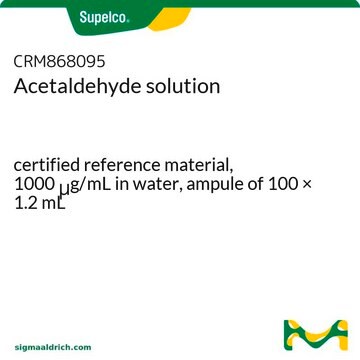About This Item
おすすめの製品
由来生物
synthetic
法規制遵守
FDA 21 CFR 177.2410
FDA 21 CFR 182.60
形状
liquid
濃度
35.00-45.00% (titration by hydroxylamine)
40 wt. % in H2O
屈折率
n20/D 1.3771
密度
0.868 g/mL at 20 °C
アプリケーション
flavors and fragrances
文書
see Safety & Documentation for available documents
食物アレルゲン
no known allergens
官能
ethereal
SMILES記法
[H]C(C)=O
InChI
1S/C2H4O/c1-2-3/h2H,1H3
InChI Key
IKHGUXGNUITLKF-UHFFFAOYSA-N
類似した製品をお探しですか? 訪問 製品比較ガイド
関連するカテゴリー
免責事項
シグナルワード
Danger
危険有害性情報
危険有害性の分類
Carc. 1B - Eye Irrit. 2 - Flam. Liq. 2 - Muta. 2 - STOT SE 3
ターゲットの組織
Respiratory system
保管分類コード
3 - Flammable liquids
WGK
WGK 3
引火点(°F)
<-0.0 °F - closed cup
引火点(℃)
< -17.78 °C - closed cup
個人用保護具 (PPE)
Eyeshields, Faceshields, Gloves, type ABEK (EN14387) respirator filter
適用法令
試験研究用途を考慮した関連法令を主に挙げております。化学物質以外については、一部の情報のみ提供しています。 製品を安全かつ合法的に使用することは、使用者の義務です。最新情報により修正される場合があります。WEBの反映には時間を要することがあるため、適宜SDSをご参照ください。
PRTR
特定第一種指定化学物質
消防法
第4類:引火性液体
第一石油類
危険等級II
水溶性液体
労働安全衛生法名称等を表示すべき危険物及び有害物
名称等を表示すべき危険物及び有害物
労働安全衛生法名称等を通知すべき危険物及び有害物
名称等を通知すべき危険物及び有害物
Jan Code
W200379-BULK:
W200379-1KG:4548173955575
W200379-PZ:
W200379-VAR:
W200379-SAMPLE:
試験成績書(COA)
製品のロット番号・バッチ番号を入力して、試験成績書(COA) を検索できます。ロット番号・バッチ番号は、製品ラベルに「Lot」または「Batch」に続いて記載されています。
この製品を見ている人はこちらもチェック
ライフサイエンス、有機合成、材料科学、クロマトグラフィー、分析など、あらゆる分野の研究に経験のあるメンバーがおります。.
製品に関するお問い合わせはこちら(テクニカルサービス)




